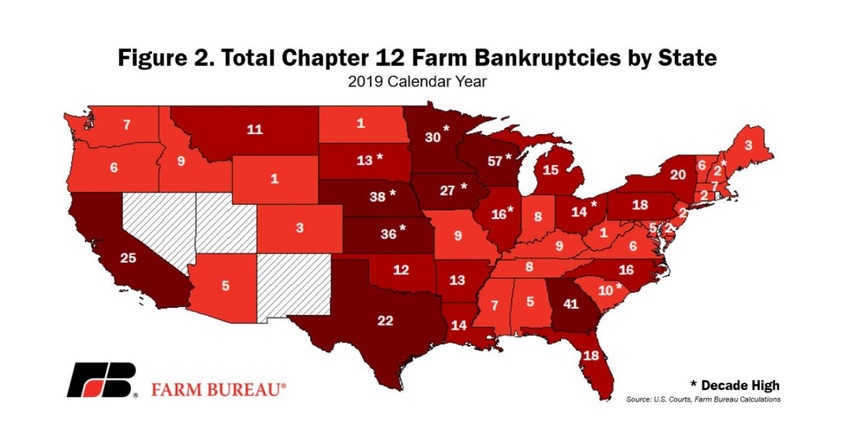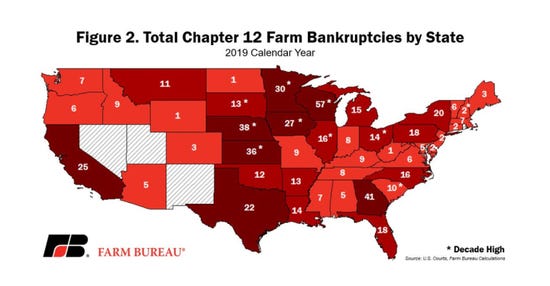Chapter 12 farm bankruptcies up 20%
Farm Bureau reports 595 Chapter 12 family farm bankruptcies during 2019 calendar year.
February 3, 2020

While well below historical highs, the number of Chapter 12 family farm bankruptcies filed in 2019 increased by nearly 20% from the previous year, according to recently released data from the U.S. Courts. During the 2019 calendar year, there were 595 Chapter 12 family farm bankruptcies, up nearly 100 filings from 2018 and the highest level since 637 Chapter 12 filings in 2011.
Compared with figures from over the last decade, the 20% increase trails only 2010, the year following the Great Recession, when Chapter 12 bankruptcies rose 33%, American Farm Bureau Federation chief economist John Newton stated in a recent "Market Intel" report.
Given that there are slightly more than 2 million farms in the U.S., the 2019 bankruptcy data reveal a rate of approximately 2.95 bankruptcies per 10,000 farms -- slightly below the rate of 2.99 filings per 10,000 farms in 2011, Newton wrote.
“The continued increase in Chapter 12 filings was not unanticipated, given the multi-year downturn in the farm economy, record farm debt, headwinds on the trade front and recent changes to the bankruptcy rules in 2019’s Family Farmer Relief Act, which raised the debt ceiling to $10 million,” he added.
During 2019, Chapter 12 farm bankruptcies were the highest in Wisconsin, which had 57 filings. Wisconsin had eight more farm bankruptcy filings than the prior year and also was at the highest level in a decade. Following Wisconsin, Georgia had 41 Chapter 12 filings in 2019, up 15 filings from 2018. Chapter 12 filings were at, tied with or above decade-high levels in 10 states: Iowa, Illinois, Kansas, Minnesota, Nebraska, New Hampshire, Ohio, South Carolina, South Dakota and Wisconsin.

Chapter 12 farm bankruptcies rose in many states across the Midwest, West and Southeast. Georgia had the largest increase in filings versus the prior year. Following Georgia were Iowa and Florida with 14 additional Chapter 12 bankruptcy filings and Nebraska with 11 additional filings.
Nearly 46% of the Chapter 12 filings were in the 13-state Midwest region, followed by 22% in the Southeast. The Midwest had 273 Chapter 12 filings, up from 234 filings in 2018, while the Southeast had 132 filings, up from 89 filings the previous year.
Newton said over the last decade, there have been more than 5,000 Chapter 12 farm bankruptcies across the U.S., representing approximately a quarter of 1% of all farm operations during this time period. At 388 filings, Chapter 12 filings over the last decade were the highest in California, followed by Wisconsin at 375 filings and Georgia at 351 filings.
Newton explained that farmers have felt the constraints of lower net farm income, although supported considerably by the Trump Administration’s Market Facilitation Program (MFP) payments due to the ongoing trade wars. Without this support, farm-related income from crop and livestock sales in 2019 inflation-adjusted dollars would have been at the second-lowest level in the last decade, at $63.6 billion, he said. Farm bankruptcies could have been worse, considering the record-high farm debt of $415 billion (in nominal terms) and the likely difficulties servicing this debt without the revenue from MFP.
“The Trump Administration is not expected to announce a third round of trade assistance, given the welcome trade news with respect to Japan, [the U.S.-Mexico-Canada Agreement] and a China phase one deal. As a result, farm financial conditions in 2020 will come down to -- notwithstanding any other black swans -- a race between the additional grain and oilseed supplies likely to come on line following a record prevented planting year and any demand boosts for U.S. agriculture that results from these new and enhanced trading opportunities,” Newton said.
You May Also Like



